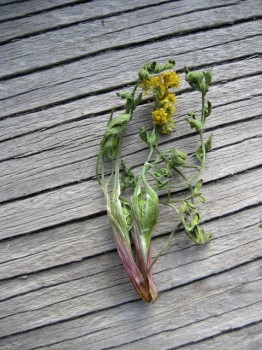
This summer, I’ll be drying more leaves.
Last season’s nettles were a no-brainer, and they disappeared from my pantry shelves fast—in the form of tea and a much-loved pumpkin nettle beer soup. But what of the other leafy greens I enjoy all summer long? Could they help to tide over a fanatical forager during the long winter months?
Inspired by Maria’s post on Lessons from the Pantry, I piled my few bottles of dried leaves on the counter last night and set to work experimenting in the hopes of determining which dried leaves merited the effort.
Here’s what I came up with:
Salted Bluebell Leaf Chips
A recent insinuation of cheesy kale chips into my life from multiple directions inspired this attempt to recreate leafy green veggie chips from a wild edible angle.
I painted the light-green, dried smooth bluebell leaves (Mertensia spp.) with a thin coat of olive oil—though a spritzer would have been ideal—then sprinkled black Hawaiian lava salt on top in the hopes of drawing out the leaves’ oceany flavor. Then I crisped them on low heat in the toaster oven—actually I crisped them at high heat and a few of them burned before I turned it down—and served to the curious fiancé.
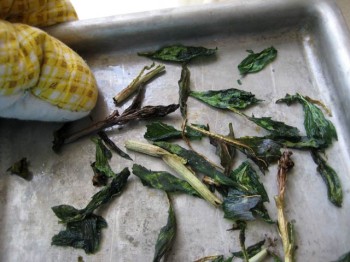
“Mmm, they melt in your mouth,” Gregg said. “Mmm.”
The bluebell chips are nowhere near as substantial as kale chips, but crunchy and yummy nonetheless. My taste buds detected the flavor immediately—power of suggestion notwithstanding—though Gregg said he did not notice it until the aftertaste.
Verdict? Good. And I think these would make a good soup topper too.
Southwestern Fireweed Tip Chips
Each spring I forage fireweed (Epilobium angustifolium) shoots—making sure not to mistake them for toxic lookalikes—and later in the season I collect the tender tips of the plant. I always try to make fireweed palatable by chopping into small bits and frying until crispy, then including in small amounts in a stir fry. Some might call that cheating. The preparation method masks a flavor I find somewhat off-putting, though I remain unwilling to admit it. Likewise, Gregg continues to make an effort to enjoy the dishes I make with fresh fireweed. We make a good match I guess.
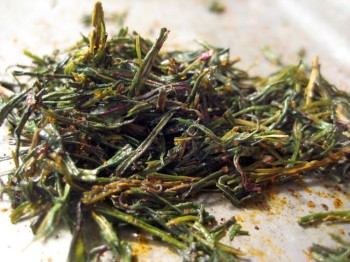
For last night’s experiment, I used a small batch of dried fireweed tips. Since the bluebell chips turned out so well, I tried a similar preparation on the fireweed, but using Penzey’s Southwestern spice mix in place of salt in the hopes of masking instead of enhancing the fireweed flavor.
Well, the flavor went ahead and enhanced itself anyway. Attractive as they were, there was a strong bitter aftertaste, and despite the fact that I admit to being a “bitter plant apologist,” I still couldn’t stomach them.
Of course, that does not mean I’ll be throwing them out. Who knows? Maybe they’d make a good soup topper.
Verdict? Not worth replicating.
Mountain Parsley Herb Butter with Red Wine Vinegar
It took me a long time to experiment with wild carrot—not of the Queen Anne’s Lace (Daucus carota) variety—but Harbouria trachypleura and Pseudocymopterus montanus, as described by Cattail Bob Seebeck (1998)—because it is a carrot/parsnip family member with poisonous lookalikes. In fact, last night was the most I’ve ever eaten of it.
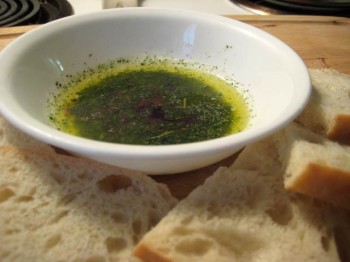
Also called mountain parsley, whiskbroom parsley, and biscuit root by Cattail Bob, the plant has an edible root best in spring and late fall/winter that I have yet to try, and leaves that taste a bit like parsley.
The specimens I collected around 11,000 feet in Colorado’s high, dry country last summer, with yellow flowers and parsley-like leaves, were relatively mild, though my friend Butterpoweredbike reported foraging a species of mountain parsley in parts lower, near Denver, and finding the flavor almost too strong to bear.
Cattail Bob recommends the leaves for herb butters, so that’s what I did.
For an afternoon snack, then, we dipped yummy bread into a simple herb butter of crushed, dried mountain parsley leaves, melted butter, olive oil, and a splash of wild grape red wine vinegar (from my first wine, gone wrong). It was delightful. Gregg was both tickled and hungry, so he sopped it up fast, incredulous that I would even think to make such a thing.
I envision herb butters and oils playing a bigger part in our lives henceforth.
Pan-Fried Potatoes with Soy and Cow Parsnip Flakes
Those who know me know I’m always trying to find more things to do with cow parsnip (Heracleum maximum), often with great success, and just as often with great disappointment. The flavor is strong so one misstep can ruin a dish, as I’ve discovered with Disgusting Cow Parsnip Chicken Soup, and Creepy Cow Parsnip Jelly. But my favorite dish, which I love, consists of lightly boiled, unfurling cow parsnip leaves served with soy sauce, butter, and chopped raw onions, a recipe from Kathryn G. and Andrew L. March (1979).
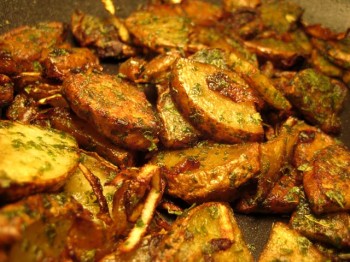
Thus, it was not without some trepidation that I set to work on these potatoes, lest I ruin the food with cow parsnip’s overpowering flavor. I decided to go with soy and onions, since those seem to work well with it. So I sliced and quartered one small potato into a pan with olive oil and thin-sliced onions cut into half-moons, then sautéed on medium heat until the potatoes softened and started to turn golden brown. Then I splashed in a tablespoon or so of soy sauce, cooked a tad longer, and doused with a generous dose (2 tbsp maybe) of dried, pulverized young cow parsnip leaves.
Verdict: Unequivocally delicious! No, seriously. Finally, another cow parsnip recipe I’ll actually use.

Do you ever harvest cow parsnip seeds, or just the leaves? I enjoy the dried seeds as a spice.
I’ve been thinking about using some of the last of my dried wild greens to make some “nori” sheets.
Huh! I’d only ever heard of eating peeled cow parsnip stems. (I haven’t tried any part yet myself though so can’t offer an opinion – it’s not common in the city and I haven’t been out to the woods enough lately.)
@Butter: I have a handful of seeds but haven’t done much with them. I keep trying to get YOU some seeds and forgetting. The nori sounds fun! I hope to come home from CT this summer with some actual seaweed too, and you are sure to share in the bounty if I am successful:)
Some sources say bluebells are toxic, what say you? Thx
Hi Eric, Great question and one that has been on my mind of late, to be honest. Bluebells of the genus Mertensia are known to contain pyrrolizidine alkaloids which are indeed toxic at high doses or with extended use. That said we do have ethnobotanical evidence of at least one Mertensia species (M. maritima) having constituted a food source for indigenous people of the Pacific Northwest. Further, a number of plants in the family Boriginaceae (of which bluebells are a part) contain these alkaloids, as well as some members of Asteraceae (of which lettuce and dandelions are part). It appears as though our livers can handle reasonable quantities of these when eaten in the context of a diverse diet while they are in season. I will be delving more deeply into the matter for a chapter in a book I am working on so I’ll circle back if I have a better response later. Hey neat to see your website and the work you do. Cheers.